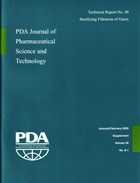Technical Report No. 40, (TR 40): Sterilizing Filtration of Gases
Premium Members: to claim your annual free technical document download, email [email protected] and indicate the document you wish to claim.
- Format
- Book
- Member Price
- $50.00
- Nonmember Price
- $100.00
Please sign in or become a member to purchase items from the PDA bookstore.
The first report, Sterilizing Filtration of Gases, is prepared by PDA Sterile Gas Filtration Committee.
The objective of the report is to assist the reader in the selection, qualification and validation of a filter that is appropriate for the application on hand. In this report, sterilizing filtration of a process gas stream is defined as the complete removal of all microbiological contaminants, excluding viruses. Under certain circumstances, other contaminants such as viruses and plasmids can also be removed by filtration. Thus, in the pharmaceutical industry, particularly in the production of parenterals, there is a wide range of processes for which sterilizing filtration of air or other process gases is appropriate and applicable.
The report emphasizes that early and careful screening of potential filter types and configurations can result in fewer technical and regulatory problems, fewer delays, more efficient processing and greater sterility assurance. Although other types of filters can be employed in the control of particulate matter and removal of liquid droplets by coalescence, the focus of this Technical Report is limited to hydrophobic membrane filter elements. While most gas applications use hydrophobic filters, this does not preclude the use of hydrophilic filters in dry gas systems.
2005. Volume 59, Issue No. S-1.
Prior to purchase please view the Terms of Usage
*To purchase licensing, please contact PDA at [email protected].
Table of Contents
Table of Contents:
1.
Introduction/Scope Statement
2. Historical Background
3. How Gas Filters
Work
4. Filter Selection and System Design Criteria
5. Examples of
Specific Applications
6. Sterilization of Hydrophobic Membrane Filters
7.
Validation of Filter Retention Capabilities
8. Physical Integrity Testing
9. User Responsibilities for the Validation of Critical
Applications
Appendix A: Theoretical Aspects of Retention Mechanisms
in Air
Appendix B: Maintenance, Preparation, and Characterization of
Brevundimonas diminuta Challenge Suspensions
Appendix C: Filter Validation
Recommendations
Appendix D: Theoretical Aspects of Integrity
Testing
References
Biography

